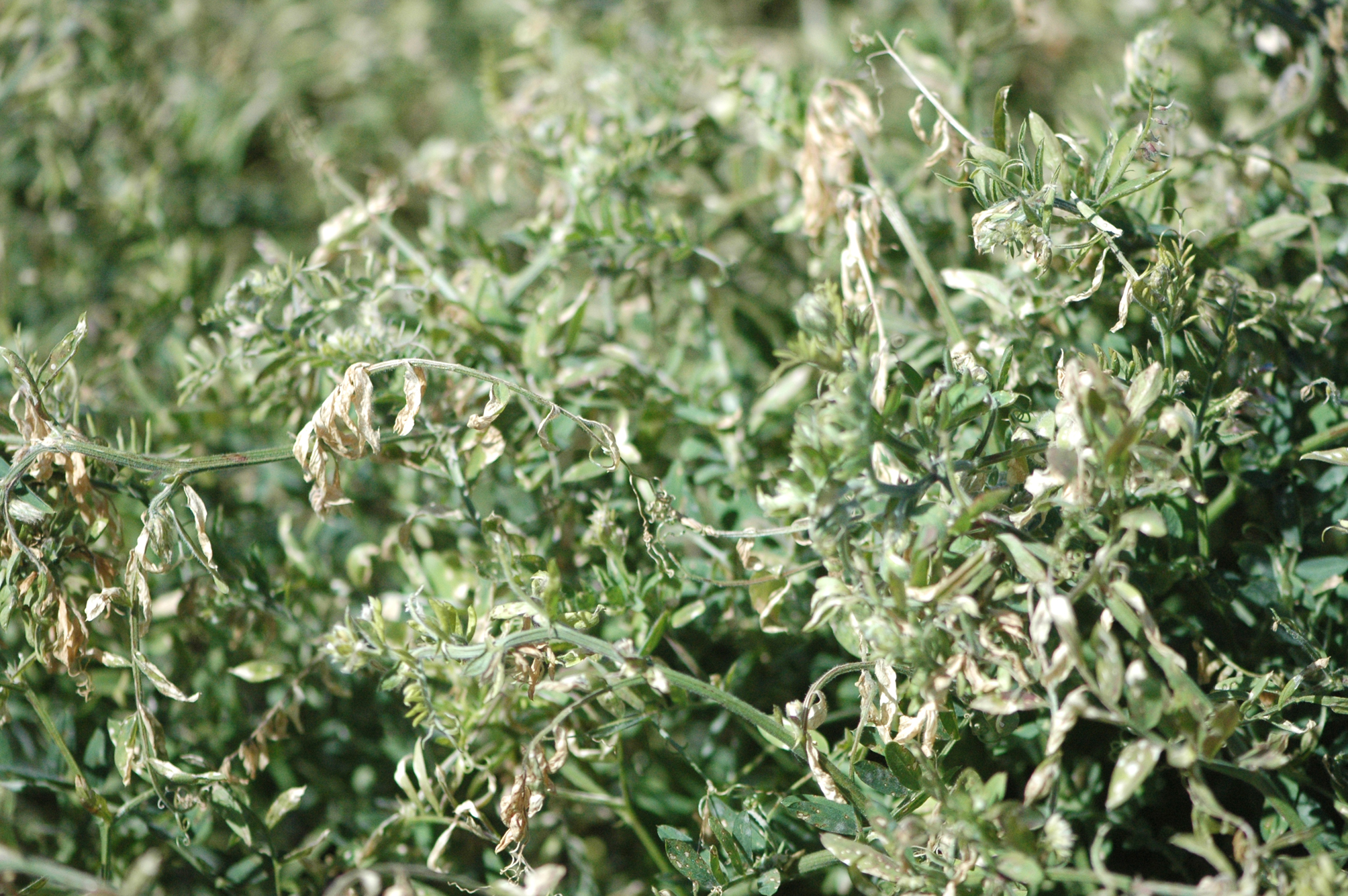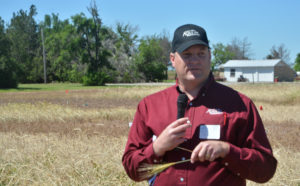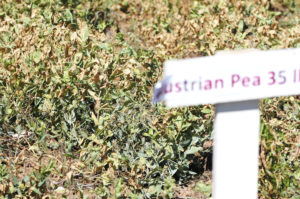Farm & Ranch
[AgriLife Extension] Rotation, cover crops impact cotton yields more than tillage

By: Kay Ledbetter
Writer: Kay Ledbetter, 806-677-5608, [email protected]
Contact: Dr. Paul DeLaune, 940-552-9941 ext. 207, [email protected]
CHILLICOTHE – After eight years of research on no-till advantages and disadvantages with cotton crops, Dr. Paul DeLaune is convinced it’s not as much about the tillage as it is about the cover crop and/or rotation.
Dr. Paul DeLaune discusses cover crops at a recent field day on the Texas A&M AgriLife Research station south of Chillicothe. (Texas A&M AgriLife Communications photo by Kay Ledbetter)
DeLaune, a Texas A&M AgriLife Research environmental soil scientist in Vernon, said he has compared no-till, strip till and conventional till, as well as cotton with a terminated wheat crop in the Rolling Plains.
“What we’ve seen over eight years is you are really not changing carbon levels,” he said. “But we shouldn’t be looking at one thing only. Even though carbon levels aren’t changing, we’ve dramatically changed some soil physical properties.”
With cotton, DeLaune said there’s not much residue, so there is little change in infiltration rates between no-till and conventional till cotton.
“But we have seen a greater infiltration rate where we have a terminated wheat crop – doubled or tripled our infiltration rates,” he said.
While the U.S. Department of Agriculture Natural Resources Conservation Service program sometimes requires a multispecies cover crop to qualify for cost share programs, depending on the county, DeLaune said he has been experimenting with both single and mixed cover crops since 2011.
The monocultures he has researched include Austrian winter field pea, hairy vetch, crimson clover and wheat, and the mixed species included rye, wheat, hairy vetch, turnips and radishes. Cover crops are planted at lower than full seeding rates, which may differ from information seen in other parts of the country, he said.
DeLaune said everyone knows cover crops aren’t free, as there is cost for the seed and use of soil moisture, but the benefits can potentially outweigh the costs over time.
Austrian Pea cover crop on the Texas A&M AgriLife Research station south of Chillicothe. (Texas A&M AgriLife Communications photo by Kay Ledbetter)
“We have maintained our cotton yields. We have seen an increase in our soil nitrogen in the upper 6 inches, particularly following legume monospecies. We have seen a visible response to cotton behind those cover crops.”
He said his team measures neutron probes in all of the cover crop research plots every other week and he has compiled four years of moisture graphs.
“Yes cover crops use water,” DeLaune said. “But some people say cover crops make water. What they are talking about is increased infiltration. We pull soil moisture down by timing of cover crop termination in mid to late April, but if we get rains in May and plant in June, we get a much higher infiltration rate and by planting season, we are back to status quo.”
He said he likes to let the wheat form a head and stem before terminating it, adding that may use a little more water, but that’s what makes the residue, which is the key to protecting the soil surface, building root biomass and subsequently infiltration.
The ultimate goal with cover crops is to build soil structure and make it more functional, he said.
“With cotton on cotton, no-till alone is probably not going to cut it,” DeLaune said. “But we’ve done very well with just a wheat cover crop, that’s a $6 or $8 treatment per acre compared to the $20 to $25 per acre with a mix of some of these species.”
But cover crops alone are not the answer, he said.
“If you are doing continuous cotton, some type of cover crop would be good, but I would encourage a crop rotation,” DeLaune said. “I have data that shows a cotton-sorghum rotation can increase carbon more rapidly, increasing carbon levels in four years under the rotation, whereas we haven’t in eight years with cotton on cotton.”
-30-
Find more stories, photos, videos and audio at http://today.agrilife.org
Farm & Ranch
Managing Show Cattle Through The Winter

By Heather Welper
Husband and wife duo, Heather and Calvin Welper, are the Co-Owners and Operators or Two C Livestock, located in Valley View, Texas.
The pair’s operation has a show cattle focus where they raise and sell purebred heifers of all breeds and club calf Hereford steers.
When it comes to show cattle, the Welpers know a thing or two including how to prepare for the cold winter months and the Texas major show season run.
To read more, pick up a copy of the November edition of North Texas Farm & Ranch magazine, available digitally and in print. To subscribe by mail, call 940-872-5922.

Farm & Ranch
Double M Ranch & Rescue

By Hannah Claxton, Editor
As the sun rises each day, so do the dozens of mouths that Meghan McGovern is responsible for getting fed. Rather than the sounds of a rooster crowing, McGovern hears the bellows and bleats of a variety of exotic deer, the chortle of kangaroos, the grunts of water buffaloes, and the chirps of a lemur.
Nestled against the banks of the Red River, the Double M Ranch and Rescue, with its high game fences and deer sprinkling the landscape,s its in stark contrast to the surrounding ranches.
“Having deer is kind of like eating potato chips- you can never actually have just one,” said McGovern with a laugh.
McGovern has several herds to take care of- fallow deer, axis deer, water buffalo, goats, and bison. In smaller numbers, there’s also a few kangaroos, a lemur, a potbelly pig, a pair of zebras, a watusi, and a few horses.
To read more, pick up a copy of the November edition of North Texas Farm & Ranch magazine, available digitally and in print. To subscribe by mail, call 940-872-5922.

Farm & Ranch
Acorn Toxicity

By Barry Whitworth, DVM, MPH
With the prolonged drought, most pastures in Oklahoma end up in poor condition. With the lack of available forage, animals may go in search of alternative foods.
If oak trees are in the pastures, acorns may be a favorite meal for some livestock in the fall. This may result in oak poisoning.
Oak leaves, twigs, buds, and acorns may be toxic to some animals when consumed.
To read more, pick up a copy of the November edition of North Texas Farm & Ranch magazine, available digitally and in print. To subscribe by mail, call 940-872-5922.

-

 Country Lifestyles2 years ago
Country Lifestyles2 years agoScott & Stacey Schumacher: A Growth Mindset
-

 Country Lifestyles8 years ago
Country Lifestyles8 years agoStyle Your Profile – What your style cowboy hat says about you and new trends in 2017
-

 HOME8 years ago
HOME8 years agoGrazing North Texas – Wilman Lovegrass
-

 Outdoor10 years ago
Outdoor10 years agoButtercup or Primrose?
-

 Country Lifestyles5 years ago
Country Lifestyles5 years agoAmber Crawford, Breakaway Roper
-

 Country Lifestyles9 years ago
Country Lifestyles9 years agoJune 2016 Profile – The man behind the mic: Bob Tallman
-

 Equine1 year ago
Equine1 year agoThe Will to Win
-

 Country Lifestyles8 years ago
Country Lifestyles8 years agoDecember 2016 Profile, Rusty Riddle – The Riddle Way






